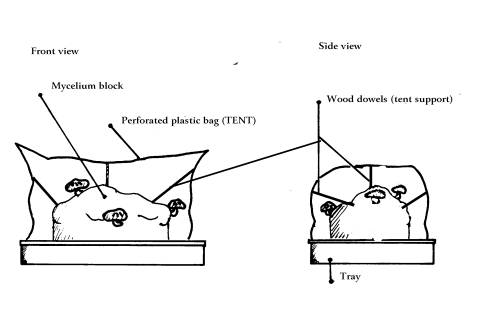The Shiitake mushroom kit you have received is made up of hardwood chips, sawdust, organic wheat bran and a small quantity of crushed limestone. It is totally chemical and additive free. The block is now probably totally white from the mycelium that has grown through the chips/sawdust mix. It will naturally turn brown on the outside to form a “skin” as it matures. This mycelium is your mushroom organism and with the proper care and stimuli it will produce “fruits” or mushrooms. The kit includes a perforated plastic bag and four wooden dowel sticks. These are to be used to set the kit up for production. To provide the stimuli necessary for mushroom “fruiting” follow these steps:
- This kit is ready to “fruit”. Remove from the plastic bag and set it up in the “tent” as pictured below and begin misting. It must be kept in a high humidity environment (75-85% RH). This can be achieved by using the perforated bag and the wooden dowels as per the drawing. Remove the block from the original plastic bag and insert the dowels into the top in an arrangement that will hold the perforated bag in a tent-like position over the block –inset dowels 1-2 inches into the top of the block, one in the middle and the other 3 around the top perimeter at a slight angle out. It is important to arrange the dowels so that the bag does not touch the block. To keep the humidity high mist the block with water at least a couple of times per day. Place the kit on a tray or pie plate large enough to catch moisture that will condense on the inside of the bag and drip down. The block of mycelium needs to “breathe”; the perforations in the bag will allow an exchange of gases. You can further facilitate gas exchange by gently patting the outside of the bag to force out CO2 laden air, and/or by lifting the bag off the block. The mushrooms require indirect light, but not direct sunlight. A shady corner, or a florescent light will provide adequate light. The light regime should be diurnal — day/night. The optimum temperature range is 18-23 °C (50-75°F). Use judgment to maintain the optimal conditions of light, moisture, and air by mimicking the conditions of a forest floor – shaded, moist, fresh.
- About a week later small bumps should start to form on the block. These will become mushrooms and once they start to form they should not be wet or they will rot. At this point it is advisable to direct the mist around the inside of the bag rather than directly onto the kit/mushrooms. The aim is to create a high humidity environment while avoiding wet/soaked mushrooms. Attention to the air quality under the tent is important – vent as necessary to force out CO2. Continue with this misting procedure until the mushrooms are about 3 inches in diameter. At this stage of mushroom development alter the misting routine in order to create a less humid environment — mist less often to produce the best quality mushrooms. Pick your mushrooms when they are 3 to 6 inches in diameter but before the cap flares out. Before harvesting remove the tent to allow the mushrooms to dry somewhat.
- After the first crop replace the block in its tent and let it rest for about 1 week. This resting period gives the mycelium a chance to digest more wood and build up its energy for the next “flush”. Mist lightly during this resting period.
- In order to initiate another flush of mushrooms following the initial fruiting the kit must be soaked overnight in cold water (avoid chlorinated water or allow it to stand for a few days to dissipate the chlorine). You can do this by placing the kit in the sink or a bucket full of water and weighting it down (otherwise it will float). Fruiting is further encouraged by “shocking” — carefully thump the soaked block on a hard surface several times without letting it break apart.
- Repeat the above cycle – resting, soaking/shocking, fruiting, harvesting — until all the nutrients embodied in the block have been used up and no more mushrooms form. Check your kit regularly for green mold. If you notice an increasing amount of green mold, moderate the spraying regime as it is likely that the micro-environment is too humid. If mold has overgrown the outside of the block you can wash it under running water.
After the kit is finished you can break it up and apply as a top dressing on garden beds or houseplants. It makes an excellent soil conditioner. The dead mycelium contributes humus, thereby increasing water retention capacity, and nutrients for soil organisms.

